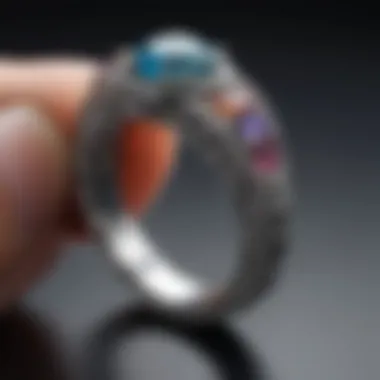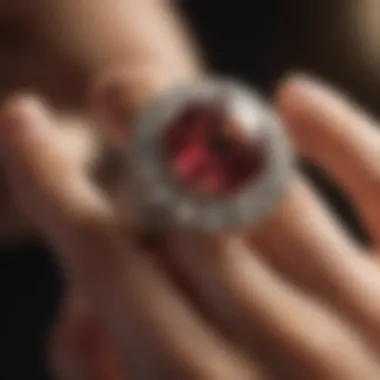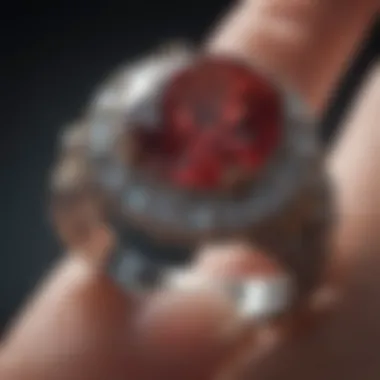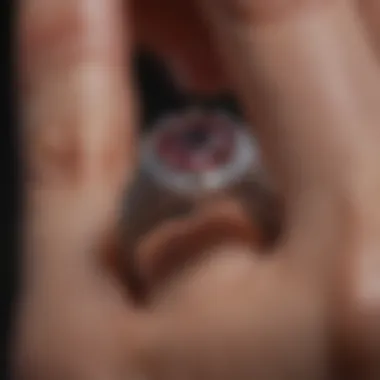Mastering Your Ring Size: Accurate Measurement Tips


Intro
Determining the right ring size is crucial when considering a ring purchase. An ill-fitting ring not only diminishes its aesthetic appeal but can also result in discomfort or damage. This guide details effective methods to accurately determine your ring size, ensuring that any ring fits securely and comfortably. Here, we will examine practical techniques, tools, and alternative methods to help you find your precise size.
Methods for Measuring Ring Size
Finding your ring size is straightforward with the right measuring techniques. Below are several methods to consider:
Using a Ring Sizer
A ring sizer is a tool specifically designed for measuring finger sizes. These are often available at jewelry stores or can be ordered online. Here’s how to use one:
- Obtain a ring sizer: You can purchase a plastic or metal sizer.
- Slide it onto your finger: Ensure it fits snugly but not too tightly.
- Choose the appropriate size: Mark the size that fits comfortably.
Measuring with Paper or String
If you do not have immediate access to a ring sizer, you can use a piece of paper or string:
- Cut a strip of paper or use a piece of string. It should be about 1/4 inch wide.
- Wrap it around the base of your finger. Make sure it is snug yet comfortable.
- Mark where the ends overlap. This gives you the circumference.
- Measure the length of the paper/string. Use a ruler to obtain the measurement.
Consider measuring your finger at different times of the day. Temperature changes can cause your fingers to expand and contract.
Using a Known Ring
Another method is to use a ring that already fits well:
- Select a ring that you wear frequently. Ensure it fits the finger you wish to measure.
- Measure the inside diameter of the ring. This can be done with calipers or a ruler.
- Consult a ring size chart to find the corresponding size.
Importance of Correct Sizing
Determining the right size is not just about aesthetics. A well-fitted ring ensures:
- Comfort: A loose ring may slip off, while a tight one can cause pain or restrict circulation.
- Longevity: Rings that fit properly are less likely to get damaged during everyday activities.
- Aesthetics: A properly sized ring looks proportional and enhances the overall appearance of the hand.
Alternative Measuring Techniques
For individuals unable to access traditional tools, consider these alternatives:
Online Ring Size Calculators
Many websites offer ring size calculators. Users input their measurements or follow guides to find their sizes.
Visiting a Local Jeweler
Consulting a jeweler is often the most reliable method. They have professional tools and experience to measure accurately.
Custom Thickness Options


For unique rings, consider custom sizing options. Well-established jewelers, like Tiffany & Co., provide accurate bespoke sizes.
End
Accurate ring size measurement is essential for comfort and style. The methods discussed in this guide help ensure you find your correct size. Always keep in mind your daily activities and finger conditions when choosing the size. The proper fit enhances both the beauty and functionality of the ring you choose.
Understanding Ring Size
Understanding ring size is a fundamental aspect of selecting and wearing rings correctly. An improperly sized ring can lead to discomfort or even loss of the piece entirely. This section delves into the specifics of ring measurement, highlighting its vital relevance in jewelry selection and crafting. Knowing one's exact ring size can prevent complications such as the ring slipping off or causing irritation. It establishes a baseline for further exploration into personal preferences regarding style and design.
Defining Ring Size
Ring size refers to the precise circumference or diameter of the finger where a ring will be worn. This measurement is typically expressed in numerical format, corresponding to specific sizing systems like the US, UK, or European standards. The various systems may present different numerical values for the same physical size. For example, a US size 7 may correspond to a UK size N. Knowing how to define and interpret these sizes is crucial for effectively navigating the market for rings, whether purchasing ready-made jewelry or opting for bespoke creations.
Why Accurate Measurement Matters
Accurate measurement of ring size is essential for several reasons. First, it enhances comfort. A well-fitting ring should feel secure without pinching or slipping. Additionally, the fit influences practicality; rings worn daily, such as wedding bands, should not impede daily activities. Moreover, the psychological implications of wearing a properly sized ring cannot be overlooked. A ring that feels comfortable and looks right can boost confidence and personal satisfaction.
"The right ring can signify more than style, it denotes a commitment and celebration of personal milestones."
In the realm of jewelry, accuracy acts as the linchpin between mere adornment and meaningful expression.
Common Misconceptions
There are several misconceptions regarding ring sizing that can mislead individuals during their measurement process. One common belief is that ring size remains constant; however, finger sizes can fluctuate due to factors such as temperature, weight changes, and time of day. Another misconception involves the reliance on vague estimates, like using string or generic measuring tools without specificity. This method often leads to inaccuracies. Another typical myth is the assertion that women typically have smaller ring sizes than men; sizes vary widely among all individuals, making each case unique. Understanding these misconceptions aids in better decision-making and encourages proper techniques for obtaining reliable measurements.
Tools Required for Measuring
To determine the correct ring size, it is vital to have the appropriate tools for measuring. Having the right instruments enables an accurate assessment of your finger size, which is crucial for ensuring comfort and fit when wearing a ring. An incorrect size can lead to discomfort, pinching, or even loss of the ring. Whether purchasing a piece of jewelry for oneself or as a gift, proper measurement is essential. This section will discuss the three most common tools used for measuring ring size: ring size gauges, measuring tape, and the string method.
Ring Size Gauges
Ring size gauges are specialized tools created specifically for measuring finger size. They often come as a set of rings in various sizes, allowing you to find the perfect fit by trying them on. The main benefit of using this tool is the ease of use. Additionally, they are commonly available at jewelry stores or can be ordered online. Because they provide a direct means of measurement, the risk of error is significantly reduced. These gauges also take into account the different styles of rings, which can affect the sizing. However, they may not always account for anomalies in finger shape, which can be a consideration for some individuals.
Measuring Tape
A flexible measuring tape is another practical tool for determining ring size. It is widely accessible and often found in household toolkits. To use this method, you simply wrap the tape around the base of the finger and note the measurement. One advantage here is that you can measure any finger, which is beneficial for those who may have varying sizes across their fingers. This method also allows for greater flexibility in measurement, as the tape can easily conform to different shapes. However, it is important to ensure that the tape is not too tight when measuring, as it can lead to inaccurate readings.
String Method
The string method is an alternative approach that can be useful, especially for individuals who do not have access to measuring tools. This method requires just a piece of string and a ruler. It is a straightforward process; however, there are some specific steps to follow to ensure accuracy.
Selecting the Correct String
When it comes to selecting the correct string, it’s important to choose a non-elastic option. This ensures that it does not stretch during measurement. A key characteristic of this method is its simplicity and the everyday accessibility of string. Using a firm and easily measurable material contributes to obtaining precise readings. However, one should be cautious not to use yarn or soft string, which may lead to discrepancies in size due to potential stretching or compression.
Marking and Measuring


Marking and measuring involve wrapping the selected string around the finger and indicating the point where it meets. After that, you would remove the string and lay it flat against a ruler to determine the size. This method is practical because it doesn’t require specialized tools. One unique feature of this method is its DIY nature, making it appealing for those looking for a quick solution. However, like with any method that involves manual handling, precision is crucial to avoid miscalculations.
"Accurate measurement is key to ensuring that a ring fits comfortably and securely, enhancing the wearing experience."
The variety of tools available for measuring ring size allows individuals to choose what is most accessible and convenient for their circumstances. Each method offers unique advantages and slight disadvantages, thus understanding each tool's functionality is essential for achieving the best results.
Measuring Techniques
Measuring techniques are essential for obtaining the right ring size. An accurate measurement ensures a comfortable fit, reducing the likelihood of discomfort or loss of the ring. In this section, we will explore various methods used to measure ring size and evaluate their effectiveness.
Direct Measurement Method
Using a Ring Sizer
Utilizing a dedicated ring sizer is one of the most accurate methods for determining your ring size. A ring sizer is a tool made up of a series of rings in different sizes. By trying on the rings, you can find the best match for your finger. This method is beneficial for several reasons.
First, it offers immediate feedback; you can directly compare the size options to your finger. A ring sizer is often made from plastic or metal, both providing a tactile feel and physical comparison. A unique feature of this tool is that it can be used multiple times, making it an economical choice for those who may need to measure ring sizes frequently. However, the main disadvantage is that it may not be available to everyone, depending on access to jewelry stores or online retailers.
Checking Against Size Charts
Another effective method for measuring ring size involves checking against size charts. Most jewelers provide standard size charts that correlate finger circumference with ring sizes. This method is beneficial for individuals who prefer a non-physical approach to sizing.
The key characteristic of this technique is its simplicity; you only need a measurement of your finger and a corresponding chart. Size charts are widely available online and can be printed at home for convenience. A unique advantage is that you can measure more than one finger and refer to the chart without needing specific tools. On the downside, this method relies on the accuracy of your initial measurement, which can lead to discrepancies if not done properly.
Wrap and Measure Technique
The wrap and measure technique offers an alternative way to find your ring size without specialized tools. In this method, a piece of string or a flexible measuring tape is wrapped around the base of your finger. Once the string is wrapped snugly but not too tightly, you mark the point where the two ends meet. After taking this measurement, you then compare it against a ring size chart. This technique is simple and can be done at home. However, it requires some care to ensure the string does not cause discomfort during the measuring process.
Using a Sample Ring
Using a sample ring is another efficient method for determining ring size. If you have a ring that fits the desired finger well, you can measure its inner diameter or circumference. This can be done using a ruler or measuring tape. This method provides a straightforward way to find your size without needing specialized tools. The drawback here is that you can only use this method if you already own a suitable ring, which may limit its applicability.
Accurate measurements are crucial when it comes to ring sizing. Ensuring that your ring fits well will enhance comfort and long-term wearability.
Adjustment Considerations
When measuring the size of a ring, there are several adjustment considerations that must be taken into account to ensure accuracy. These factors can influence the fit of a ring significantly, often leading to discomfort or, worse, a lost ring. Accuracy is key, as a ring that fits well not only looks good but also offers a degree of comfort that enhances the wearer's experience. In this section, we will delve into three primary factors: swelling and temperature changes, time of day, and finger shape variations.
Swelling and Temperature Changes
One of the most crucial aspects to consider when determining ring size is the natural fluctuation of finger size throughout the day. Temperature plays a significant role here. For example, in warmer weather, fingers may swell, making them appear larger than at cooler temperatures. Conversely, cold temperatures can cause fingers to shrink slightly.
To mitigate this issue, individuals should measure their ring size at a time when their fingers are at a moderate state, avoiding extremes of temperature. It is wise to take multiple measurements at different times and under varying conditions. This can help identify an average size that accommodates these fluctuations.
Time of Day
The time of day also influences the size of the finger, particularly after exertion or during various health-related activities. Fingers tend to swell throughout the day owing to fluid retention and activity. Measuring in the morning, before the body has had a chance to retain excess fluid, often yields a smaller, more stable size. Therefore, it is advisable to measure in the evening, allowing for some swelling, but ideally not right after physical activity. By choosing an appropriate time for measurement, one can gain a better understanding of the correct size.


Finger Shape Variations
Finger shape varies among individuals and can have a significant impact on ring fit. Some people have wider knuckles, while others may have a more tapered shape. This can lead to complications when fitting a ring. If a ring fits comfortably over the knuckle but is too tight for the finger underneath, it is likely to become uncomfortable.
To deal with this, some may benefit from trying on rings in different styles or considering rings that can adjust slightly in size. Assessing one's own finger shape and size can help in understanding how to choose a ring that fits properly across the entire finger, not just in isolated spots.
It is paramount to consider these adjustment factors as they ensure a more accurate determination of ring size. Ignoring them can result in poor fitting rings that cause discomfort or even loss.
Alternative Methods for Ring Sizing
Determining the correct ring size is crucial, especially if you are purchasing a ring as a gift or planning to propose. In this section, we will delve into some valuable alternative methods for ring sizing, useful when traditional measuring tools or techniques are not available. Considering these methods can significantly help ensure that your ring fits comfortably and securely.
Professional Measurements at Jewelers
If you want the most accurate ring size, visiting a jeweler is often the best option. Professional measurements at jewelers involve using precise measuring tools and techniques that are essential for obtaining the perfect fit. Jewelers typically use a set of plastic or metal ring sizers that can match the exact size of your finger.
The benefits of having a professional measurement include:
- Accuracy: Jewelers often provide a more precise measurement than personal methods.
- Experience: Professionals know how to account for unique factors like your finger shape or swelling.
- Immediate Feedback: You can try on multiple rings to find the best fit right away.
Nevertheless, it's worth noting that some jewelers may charge a small fee for this service or require an appointment, so plan accordingly. This method is ideal for anyone unsure about measuring their own ring size.
Online Ring Size Calculators
For those who prefer convenience or cannot visit a jeweler, online ring size calculators offer a practical solution. These tools are often free and user-friendly, allowing you to determine your ring size from the comfort of your home. They typically require you to input measurements you have taken or use a printable ring sizer they offer.
Here are some points to consider when using online ring size calculators:
- Variety of Options: Many calculators exist, providing different measurements based on your preferences or needs.
- Convenience: You can measure your size anytime without needing an appointment.
- Printable Sizers: Some websites allow you to print a ring sizer which can be used to check against an existing ring or to measure your finger directly.
However, accuracy can vary based on how carefully you follow instructions. Ensure you use a trusted website to guarantee the credibility of its sizing methods.
"Whether visiting a jeweler or using an online calculator, the goal is the same: to find a ring that feels perfect on your finger."
By exploring these alternative methods for sizing, you will empower yourself to make informed decisions when selecting the ideal ring that fits beautifully and comfortably.
End
Determining the correct ring size is a crucial step in the jewelry selection process. An ill-fitting ring can lead to discomfort and even the loss of the piece. This article has provided various methods for accurately measuring ring size, emphasizing several factors that influence this process.
Recap of Key Methods
A summary of the effective methods for measuring ring size includes:
- Direct Measurement Method: Using a professional sizing tool or checking against a size chart is reliable.
- Wrap and Measure Technique: A simple and practical approach using measuring tape or string for anyone at home.
- Using a Sample Ring: Utilizing a ring that already fits correctly offers a straightforward comparison.
- Professional Measurements at Jewelers: Engaging a jeweler ensures a high degree of accuracy.
- Online Ring Size Calculators: A convenient alternative for quick estimations when immediate tools are unavailable.
These methods offer a range of options for determining ring size accurately, making it accessible for everyone.
Next Steps in Ring Selection
After knowing your ring size, the journey does not end. Next steps involve researching the type of ring you wish to purchase or craft. Consider the following:
- Material: Explore different materials such as gold, silver, or platinum and their durability.
- Style: Decide on a design that complements personal taste and lifestyle.
- Gemstone Choice: Depending on your preference, the selection of gemstones can define the ring's essence.
- Setting Style: The way the stone is set can greatly influence the ring's overall appearance and security.
Careful consideration of these elements along with your accurate ring size will ensure that the final selection meets both aesthetic and functional demands. Overall, the proper sizing process enhances the likelihood of satisfaction with the ring, making it a cherished accessory.



